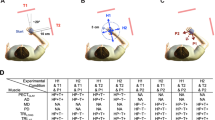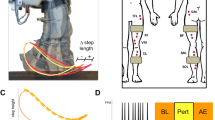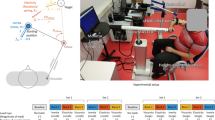Abstract
Recent work has shown that preplanned motor programs can be rapidly released via fast conducting pathways using a startling acoustic stimulus. Our question was whether the startle-elicited response might also release a recently learned internal model, which draws on experience to predict and compensate for expected perturbations in a feedforward manner. Our initial investigation using adaptation to robotically produced forces showed some evidence of this, but the results were potentially confounded by co-contraction caused by startle. In this study, we eliminated this confound by asking subjects to make reaching movements in the presence of a visual distortion. Results show that a startle stimulus (1) decreased performance of the recently learned task and (2) reduced after-effect magnitude. Since the recall of learned control was reduced, but not eliminated during startle trials, we suggest that multiple neural centers (cortical and subcortical) are involved in such learning and adaptation. These findings have implications for motor training in areas such as piloting, teleoperation, sports, and rehabilitation.





Similar content being viewed by others
References
Brashers-Krug T, Shadmehr R, Bizzi E (1996) Consolidation in human motor memory. Nature 382:252–255
Burgess JK, Haner R, and Patton JL (2007) Generalization of motor adaptation skills from bimanual-grasp to individual limbs. IEEE Trans Neural Eng Rehabil 15
Campbell AD, Squair JW, Chua R, Inglis JT, Carpenter MG (2013) First trial and StartReact effects induced by perturbations to upright stance. J Neurophysiol 110:2236–2245
Carlsen AN (2011) Considerations for the use of a startling acoustic stimulus in studies of motor preparation in humans. Neurosci Biobehav Rev 25:366–376
Carlsen AN, Mackinnon CD (2010) Motor preparation is modulated by the resolution of the response timing information. Exp Brain Res 1322:38–49
Carlsen AN, Chua R, Inglis JT, Sanderson DJ, Franks IM (2003) Startle response is dishabituated during a reaction time task. Exp Brain Res 152:510–518
Carlsen AN, Chua R, Inglis JT, Sanderson DJ, Franks IM (2004a) Can prepared responses be stored subcortically? Exp Brain Res 159:301–309
Carlsen AN, Chua R, Inglis JT, Sanderson DJ, Franks IM (2004b) Prepared movements are elicited early by startle. J Motor Behav 36:253–264
Carlsen AN, Chua R, Dakin CJ, Sanderson DJ, Inglis JT, Franks IM (2008) Startle reveals an absence of advance motor programming in a Go/No-go task. Neurosci Lett 434:61–65
Carlsen AN, Almeida QJ, Franks IM (2012) Startle decreases reaction time for active inhibition. Exp Brain Res 123:21–33
Carlsen AN, Almeida QJ, Franks IM (2013) Using a startling acoustic stimulus to investigate underlying mechanisms of bradykinesia in Parkinson’s disease. Neuropsychologia 51:392–399
Cunningham HA (1989) Aiming error under transformed spatial mappings suggests a structure for visual-motor maps. J Exp Psychol 15:493–506
Donchin O, Rabe K, Diedrichsen J, Lally N, Schoch B, Gizewski ER, Timmann D (2012) Cerebellar regions involved in adaptation to force field and visuomotor perturbation. J Neurophysiol 107:134–147
Flanagan JR, Rao AK (1995) Trajectory adaptation to a nonlinear visuomotor transformation: evidence motion planning in visually perceived space. J Neurophysiol 74:2174–2178
Gandolfo F, Mussa-Ivaldi FA, Bizzi E (1996) Motor learning by field approximation. Proc Natl Acad Sci USA 93:3843–3846
Held R, Schlank M (1959) Adaptation to disarranged hand-eye coordination in the distance-dimension. Am J Psychol 72:603–605
Imamizu H, Miyauchi S, Tamada T, Sasaki Y, Takino R, Putz B, Yoshioka T, Kowata M (2000) Human cerebellar activity reflecting an acquired internal model of a new tool. Nature 403:192–195
Kawato M (1999) Internal models for motor control and trajectory planning. Curr Opin Neurobiol 9:718–727
Krakauer JW, Pine ZM, Ghilardi MF, Ghez C (2000) Learning of visuomotor transformations for vectorial planning of reaching trajectories. J Neurosci 20:8516–8924
Krakauer JW, Ghilardi MF, Mentis M, Barnes A, Veytsman M, Eidelberg D, Ghez C (2004) Differential cortical and subcortical activations in learning rotations and gains for reaching: a PET study. J Neurophysiol 91(924):933
Kumru H, Urra X, Compta Y, Castellote JM, Turbau J, Valls-Solé J (2006) Excitability of subcortical motor circuits in Go/noGo and forced choice reaction time tasks. Neurosci Lett 406:66–70
MacKinnon CD, Bissig D, Chiusano J, Miller E, Rudnick L, Jager C, Zhang Y, Mille ML, Rogers MW (2007) Preparation of anticipatory postural adjustments prior to stepping. J Neurophysiol 97:4368–4379
MacKinnon CD, Allen DP, Shiratori T, Rogers MW (2013) Early and unintentional release of planned motor actions during motor cortical preparation. Plos One 8(5):1–9
Marinovic M, Tresilian JR, de Rugy A, Sindhu S, Riek S (2014) Corticospinal modulation induced by sounds depends on action preparedness. J Physiol 592:153–169
Maschke M, Gomez CM, Ebner TJ, Konczak J (2004) Hereditary cerebellar ataxia progressively impairs force adaptation during goal-directed arm movements. J Neurophysiol 91:230–238
Maslovat D, Carlsen AN, Ishimoto R, Chua R, Franks IM (2008) Response preparation changes following practice of an asymmetrical bimanual movement. Exp Brain Res 190:239–249
Maslovat D, Carlsen AN, Chua R, Franks IM (2009) Response preparation changes during practice of an asynchronous bimanual movement. Exp Brain Res 195:383–392
Maslovat D, Franks IM, Leguerrier A, Carlsen A (2015) Reponses to startling acoustic stimuli indicate that movement-related activation is constant prior to action: a replication with an alternate interpretation. Physiol Rep. doi:10.14814/phy2.12300
Nonnekes J, Oude Nijhuis LB, de Niet M, de Bot ST, Pasman JW, van de Warrenburg BPC, Bloem B, Weerdesteyn V, Geurts A (2014) StartReact restores reaction time in HSP: evidence for subcortical release of a motor program. J Neurosci 34:275–281
Patton JL, Mussa-Ivaldi FA (2002) Linear combinations of nonlinear models for predicting human-machine interface forces. Biol Cybern 86:73–87
Patton J, Wie Y, Scharver C, Kenyon R, Scheidt R (2006) Motivating rehabilitation by distorting reality. BioRob 2006 The first IEEE/RAR-EMBS international conference on biomedical robotics and biomechatronics, Pisa, Tuscany, Italy, February 20–22
Reynolds RF, Day BL (2007) Fast visuomotor processing made faster by sound. J Physiol 583:1107–1115
Roby-Brami A, Burnrod Y (1995) Learning a new visuomotor transformation: error correction and generalization. Cogn Brain Res 2:229–242
Shadmehr R, Mussa-Ivaldi FA (1994) Adaptive representation of dynamics during learning of a motor task. J Neurosci 14:3208–3224
Shadmehr R, Smith MA (2005) Intact ability to learn internal models of arm dynamics in Huntington’s disease but not cerebellar degeneration. J Neurophysiol 93:2809–2821
Tresch UA, Perreault EJ, Honeycutt CF (2014) Startle evoked movement is delayed in older adults: implication for brainstem processing in the elderly. Physiol Rep. doi:10.141814/phy2.12025
Tseng Y, Diedrichsen J, Krakauer JW, Shadmehr R, Bastian AJ (2007) Sensory prediction errors drive cerebellum-dependent adaptation reaching. J Neurophysiol 98:54–62
Valls-Solé J, Solé F, Vallderiola F, Munoz E, Gonzalez LE, Tolosa ES (1995) Reaction time and acoustic startle in normal human subjects. Neurosci Lett 195:97–100
Valls-Solé J, Valldeoriola F, Tolosa E, Nobbe F (1997) Habituation of the auditory startle reaction is reduced during preparation for execution of a motor task in normal human subjects. Brain Res 751:155–159
Valls-Solé J, Rothwell JC, Goulart F, Cossu G, Muñoz E (1999a) Patterned ballistic movements triggered by a startle in healthy humans. J Physiol (Lond) 516:931–938
Valls-Solé J, Rothwell JC, Goulart F, Cossu G, Munoz E (1999b) Patterned ballistic movements triggered by a startle in healthy humans. J Physiol 516:931–938
Wei Y, Bajaj P, Scheidt R, Patton J (2005) Visual error augmentation for enhancing motor learning and rehabilitative relearning. IEEE international conference on rehabilation robotics, Chicago, IL, USA
Wright ZA, Rogers MW, MacKinnon CD, Patton JL (2009) Startle stimuli reduce the internal model control in discrete movements. IEEE engineering in medicine and biology conference, Minneapolis, MN, USA
Wright ZA, Ravichaandran V, Patton JL (2011) Startle reduces recall of a recently learned internal model. IEEE international conference on rehabilitation robotics, Zurich, Switzerland
Acknowledgments
We thank Mark Shapiro for use of his Delsys EMG system and Vess Djeov for his technical assistance.
Conflict of interest
The authors declare that they have no conflict of interest.
Author information
Authors and Affiliations
Corresponding author
Rights and permissions
About this article
Cite this article
Wright, Z.A., Carlsen, A.N., MacKinnon, C.D. et al. Degraded expression of learned feedforward control in movements released by startle. Exp Brain Res 233, 2291–2300 (2015). https://doi.org/10.1007/s00221-015-4298-5
Received:
Accepted:
Published:
Issue Date:
DOI: https://doi.org/10.1007/s00221-015-4298-5




